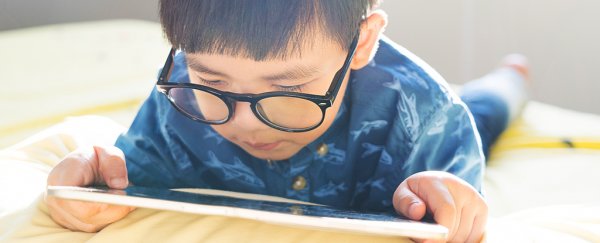School closures are among the more controversial options for controlling the COVID-19 pandemic, with authorities debating whether the preventative measure is worth the potential educational, social, and emotional costs.
Researchers in China have uncovered yet another health concern faced by children kept in isolation for extended periods; deteriorating eyesight.
Short-sightedness – what is medically referred to as myopia – is already a concerning problem in East Asian countries, prompting China to make it a health priority in recent years.
One of its public programs is an annual eye exam for school children. Based on a diagnostic process called photoscreening, the system captures light-induced reflexes in each eye, giving technicians a snapshot of refractive errors or misalignments in crucial eye anatomy.
Researchers used photoscreening records from children in 10 Shandong elementary schools, all collected at the start of every school year since 2015.
With COVID forcing the closure of schools for the first half of 2020, a new school year was kicked off in June rather than the usual September. But the usual screening took place nonetheless, giving eye specialists and researchers a good look at the eyes of thousands of children aged six to 13.
All up, the five consecutive years of testing provided the scientists with a glimpse into a total of 389,808 eyeballs.
An analysis of the frequency of refractive errors found in all of those eyes revealed a relatively stable trend from 2015 to 2019, with perhaps a slight shift towards myopia.
That shift was unmistakable in 2020's results though, with a substantial jump in errors that qualify as short-sightedness, significantly among six to eight year olds.
In fact, the prevalence of myopia in children aged six was three times more than in those of any previous year.
While we can only speculate over the cause of the widespread change, staring intently at books and screens for long periods while isolated indoors will do the trick just nicely.
"This substantial myopic shift was not seen in any other year-to-year comparison, making the cause possibly due to the unusual occurrence of home confinement in 2020," the researchers suggest in their report.
It's possible the fact the screening took place in June rather than September, together with all of the masking and distancing precautions that come with pandemic safety, just might have somehow affected the results.
But the differences weren't consistent across all ages tested, making it unlikely confounding factors are to blame.
Just why some ages were more affected than others is a bit of a mystery. Given younger children were typically assigned fewer tasks to complete under home schooling, variations in screen-time or differences in amounts of near-sighted work probably aren't enough to explain what's going on.
Spending time outdoors is known to help, but again, it's hard to argue that there's any big difference between the amount of time six- and 13-year-olds spend outdoors.
What is looking likely is that six-year-olds are simply going through development that is more sensitive to environmental effects. It's possible that with a longer window of isolation, even older children would soon face challenges with their sight.
"If that is the case, the period of environmental change may be the main risk factor for myopia development, with the younger children more sensitive to the environmental change than the older children," the team writes.
"Children aged six to eight years may be experiencing an important period for myopia development."
It's a hypothesis that requires further research to confirm one way or another.
In any case, the results strongly suggests that spending copious amounts of time indoors during our childhood increases the risk to our vision.
This isn't to say we need schools to be open for the sake of our children's eyes. With the pandemic far from over, it's important we do everything we can to save lives by isolating where necessary.
But knowing how isolation can affect our children's development means we can take measures to reduce its impact.
Limiting screen time, keeping digital media half a metre away (at least 18 inches or so) from the face and spending time outside each day where possible could be enough to mitigate at least some of the effects isolation indoors has on sight.
COVID-19 has taken enough of a toll on humanity's health. Our eyesight doesn't need to be another cost.
This research was published in JAMA Ophthalmology.
